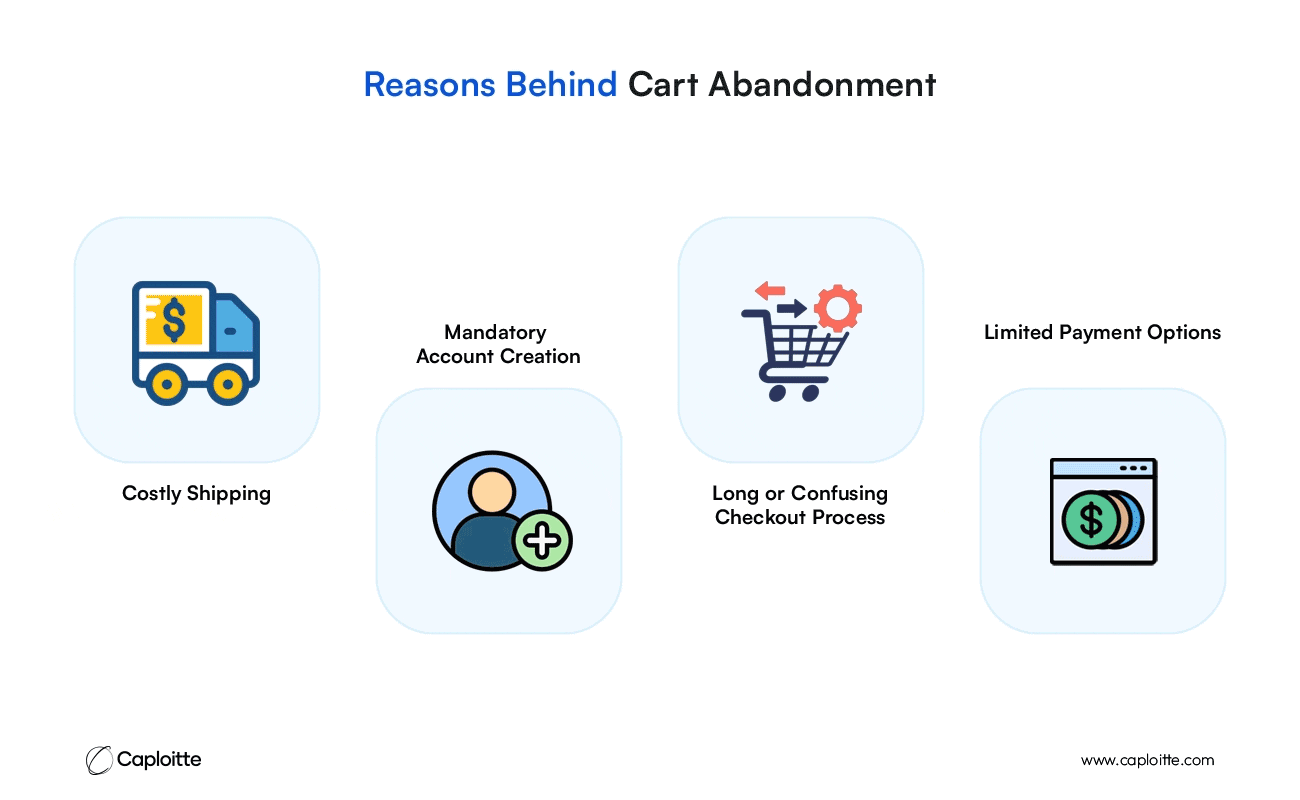How to Reduce Cart Abandonment Rates on Your E-commerce Site?
-
Caploitte
-
29 April 2025
-
05 Min Read
Identifying the Reasons Behind Cart Abandonment
Common Causes of Cart Abandonment
How to Optimize the Checkout Process to Increase Conversions?
How Does Performance and Speed of the Website Lower the Cart Abandonment?
Easy Ways to Build Trust and Encourage More Conversions
Strategies for Cart Recovery to Get Customers Back
Conclusion
Cart abandonment happens when online shoppers add items to their cart but leave without completing the purchase. This is a typical problem that E-commerce companies encounter. According to studies, 60–80% of customers give up on their carts. This implies that a large number of prospective sales are lost before they are completed. Improving internet sales requires an understanding of the reasons behind this.
Sales and customer satisfaction are negatively impacted when shoppers leave their carts unattended. Companies lose out on income and chances to turn website visitors into devoted customers. Credibility and brand trust are also impacted by this problem. However, companies can reduce cart abandonment rates by using focused initiatives. These tactics include streamlining the checkout process, enhancing website performance, and providing a variety of payment choices. Resolving these problems can improve customer satisfaction and conversion rates.
Identifying the Reasons Behind Cart Abandonment

The problem of cart abandonment is pervasive in E-commerce. Numerous things cause buyers to leave before making a purchase. To properly address these reasons, businesses must comprehend them. While some factors are directly tied to cost, others have to do with user experience. Reducing cart abandonment and increasing sales start with identifying these pain points. Businesses can improve the shopping experience by making adjustments after they understand the reasons for customers’ departures.
Common Causes of Cart Abandonment
Costly shipping is one of the main causes of cart abandonment. According to studies, expensive delivery costs drive away 55% of internet buyers. Customers frequently decide not to make the transaction when they discover hidden fees at checkout. The obligation to register for an account before making a purchase is another important problem. Because they don’t want to register in order to make a purchase, about 34% of customers depart. For convenience, a lot of people favor guest checkout.
1. Confusing or Long Process
Abandonment might also result from a drawn-out or unclear checkout process. A quarter of consumers give up on their carts because the process is confusing or takes too long. 17% of consumers leave the store without making a purchase due to security concerns, such as worries about disclosing credit card information. Furthermore, when consumers are unable to locate their preferred payment option, 6% of them leave their carts empty.
2. Behavioral Perspectives
It’s critical to comprehend the behaviors of online shoppers. 92% of first-time visitors, according to research, do not plan to buy right away. Rather, they are perusing and contrasting alternatives. This implies that companies need to concentrate on winning those clients back. And ought to give priority to their follow-up marketing initiatives.
How to Optimize the Checkout Process to Increase Conversions?

A well-optimized checkout process can significantly lower cart abandonment. A lot of consumers abandon their carts because the checkout process is too complicated or takes too long. Customers will be able to finish their purchases more quickly if this process is made simpler. A seamless purchasing experience reduces the likelihood of cart abandonment among customers. The likelihood of losing a sale rises with each additional stage and complexity. Companies need to concentrate on developing a simple and easy checkout process.
1. Gestures Making the Checkout Process Simpler
Checkout should be an easy and uncomplicated process. A drawn-out, difficult checkout process frequently irritates clients. Businesses should shorten the process of making a purchase in order to increase conversions. Providing a one-step checkout process is an excellent fix. Customers may now swiftly complete their orders without being bogged down by forms or numerous pages thanks to this. Customers can also see how close they are to finishing their purchase by adding a progress indicator. They may be motivated to complete the task by this visual aid.
2. Providing Options for Guest Checkout
Another frequent cause of cart abandonment is requiring users to register for an account. A lot of customers don’t want to spend the effort registering. 34% of consumers give up on their shopping when prompted to register for an account. This issue is resolved by allowing guests to check out without registering. Due to its ease of use, this option is particularly popular with first-time consumers. Businesses can continue to provide individualized experiences even after a customer has made a purchase by urging account creation or following up with emails. Customers feel appreciated in this way without feeling compelled to sign up in advance.
How Does Performance and Speed of the Website Lower the Cart Abandonment?

A key factor in lowering cart abandonment is your E-commerce site’s technical performance. Users become frustrated and leave a website that loads slowly. In fact, studies reveal that a cart’s desertion rate may rise by as much as 75% during poor load times. Consumers anticipate a seamless, quick experience, so if your website takes longer than a few seconds to load, they might give up and shop elsewhere. Improving the overall shopping experience and retaining prospective customers require you to optimize the speed of your website.
1. Page Loading Speed and User Experience
One of the most crucial elements of a good user experience is speed. When a website loads slowly, users become impatient and click away. Businesses should concentrate on optimizing load speeds for desktop and mobile devices in order to lessen this problem. Improved load times can be achieved by methods including caching, image optimization, and the use of a content delivery network (CDN). With the use of content delivery networks (CDNs), consumers can access websites from servers that are closer to their location. Essential data is cached to save users from having to reload the complete website on each visit.
2. Mobile-Friendly Design and Optimization.
It’s essential to optimize for mobile devices given the growth of mobile commerce. Mobile optimization should be prioritized because around 85.65% of mobile shoppers abandon their carts. By using responsive design, you can make sure that your website works well on tablets and smartphones by adjusting to different screen sizes. Additionally, by offering quicker, simplified versions of your website, Google’s Accelerated Mobile Pages (AMP) can enhance mobile performance. Eliminating pointless pop-ups and advertisements from mobile checkout pages contributes to a concentrated, user-friendly experience that motivates users to finish their transactions.
Easy Ways to Build Trust and Encourage More Conversions

Building trust is essential for E-commerce, not simply a suggestion. Customers hesitate when there is no confidence. Many of them decide not to finish their purchases because they regret their choices. They must experience security. Customers will proceed with their transactions with confidence if your store appears trustworthy and transparent. Conversions are aided by trust, which is developed via open communication and obvious security precautions. Ensuring that consumers feel secure and educated throughout the whole purchasing process, lowers cart abandonment.
1. Transparent and Simple Shipping Policies
Many people will give up on their cart if there are unanticipated expenses when checking out. It’s critical to be clear and honest about shipping charges right away. Don’t wait until the last minute to show them. Providing free or tier-based flexible shipping choices can also be a game-changer. Customers enjoy having options. Furthermore, instilling a sense of urgency through offers of same-day shipment or precise delivery dates can encourage clients to finish their purchases faster. These tactics cut down on reluctance and maintain client interest.
2. Security and Trust Badges on Display
The primary concern of online customers is security. Before clicking “buy,” people want to be sure that their information is secure. Putting trust badges and SSL certificates on display, such as those from Norton or McAfee, gives confidence. These badges alert visitors to the security of your website. A lot of consumers actively search for these symbols before making a purchase. However, trust goes beyond that. Including evaluations and quotes from actual clients lends even more legitimacy. Customers feel more at ease completing their purchases when they witness others having positive experiences.
3. Offer Convenient and Adaptable Payment Options
Easy and adaptable payment methods are essential to a seamless checkout process. Customers are more likely to complete their transactions when they can easily locate and apply their preferred payment option. Businesses may reduce cart abandonment and boost sales by providing customers with a variety of options and streamlining the process.
4. Increasing the Number of Payment Options
Different payment methods are preferred by different customers. It is imperative to provide an array of gateway options like as Stripe, PayPal, or Apple Pay. Newer strategies like “Buy Now, Pay Later” (BNPL) or installment payments, in addition to these tried-and-true techniques, can motivate customers to finish their orders. With these alternatives, clients can spread out payments over time and manage larger purchases more simply. The capability to save payment details for upcoming transactions is an additional convenience. One-click options make it easier and less complicated for returning consumers to check out quickly by eliminating the need to enter their information again.
5. Clear Pricing Without Unexpected Charges
Unexpected expenses are disliked by all. Hidden costs, such as taxes or additional delivery costs, can result in cart abandonment. Businesses should be open and honest about their prices right away in order to avoid this. Early in the purchasing process, displaying an all-inclusive price fosters trust and helps to avoid unpleasant surprises. Customer understanding of the whole cost can be facilitated by using tools such as estimators or pricing calculators on product pages, even before they check out. Businesses may boost conversion rates and offer a more seamless purchasing experience by eliminating last-minute shocks.
Strategies for Cart Recovery to Get Customers Back

Businesses can entice customers who left without finishing their transaction to return with the correct recovery strategies. Re-engaging with clients after they have abandoned their buying cart can convert prospective losses into actual sales. When it comes to retrieving abandoned carts, tools like email marketing and push notifications can make a big difference.
1. Use Push Notifications
Push notifications are a great way to remind customers about things they still need to buy. Customers can be guaranteed to receive reminders immediately after they leave their cart by configuring automated alerts. When sending the initial reminder, it is best to do so within a couple of hours, when their attention is still piqued. Customized messages that offer exclusive discounts or suggest related products depending on what the user left in their basket should be included in these messages. Limited-time deals that create a sense of urgency can entice customers to come back and finish their transaction. Should the initial alert prove ineffective, a follow-up reminder that is sent out after 12 or 24 hours may offer a helpful prod to complete the transaction.
2. Email Marketing
Another successful strategy for regaining lost business is email marketing. Personalized emails about cart abandonment with attention-grabbing subject lines work wonders. A notice that reads, “You left something behind!” alerts customers to their neglected cart and entices them to return. In these communications, providing free shipping or limited-time discounts adds even more incentive. Here, A/B testing is a crucial tactic. Businesses may determine what resonates most with their audience by experimenting with various subject lines and email templates. Testing and optimization done on a regular basis guarantee that more abandoned carts are found and converted into profitable transactions.
Conclusion
Preparing and implementing a strategic plan is necessary to lower cart abandonment. The checkout procedure should be made as simple as possible, with multiple payment alternatives offered and all expenses clearly disclosed. Enhancing a website’s efficiency and speed is equally important because lag time might turn off visitors. Customers are kept interested and are more likely to finish their transaction when trust is established by open and honest policies, security features, and social evidence.
However, optimization is a continuous process. For long-term success, it is imperative to routinely evaluate the user experience in order to pinpoint and resolve pain areas. Devices such as push alerts, customized email marketing, and guest checkout capabilities assist companies in bringing back lost revenue and increasing conversion rates. E-commerce companies may decrease cart abandonment, increase revenue, and give their customers a better purchasing experience by adopting a comprehensive strategy and improving every part of the customer journey.
Share this post:
Read More
- All
- AI
- AR
- DevOps and CI/CD
- E-commerce
- FinTech
- IoT
- Mobile Development
- Outstaffing
- Security
- SEO
- Tech Trends
- Web Design
- Web Development




